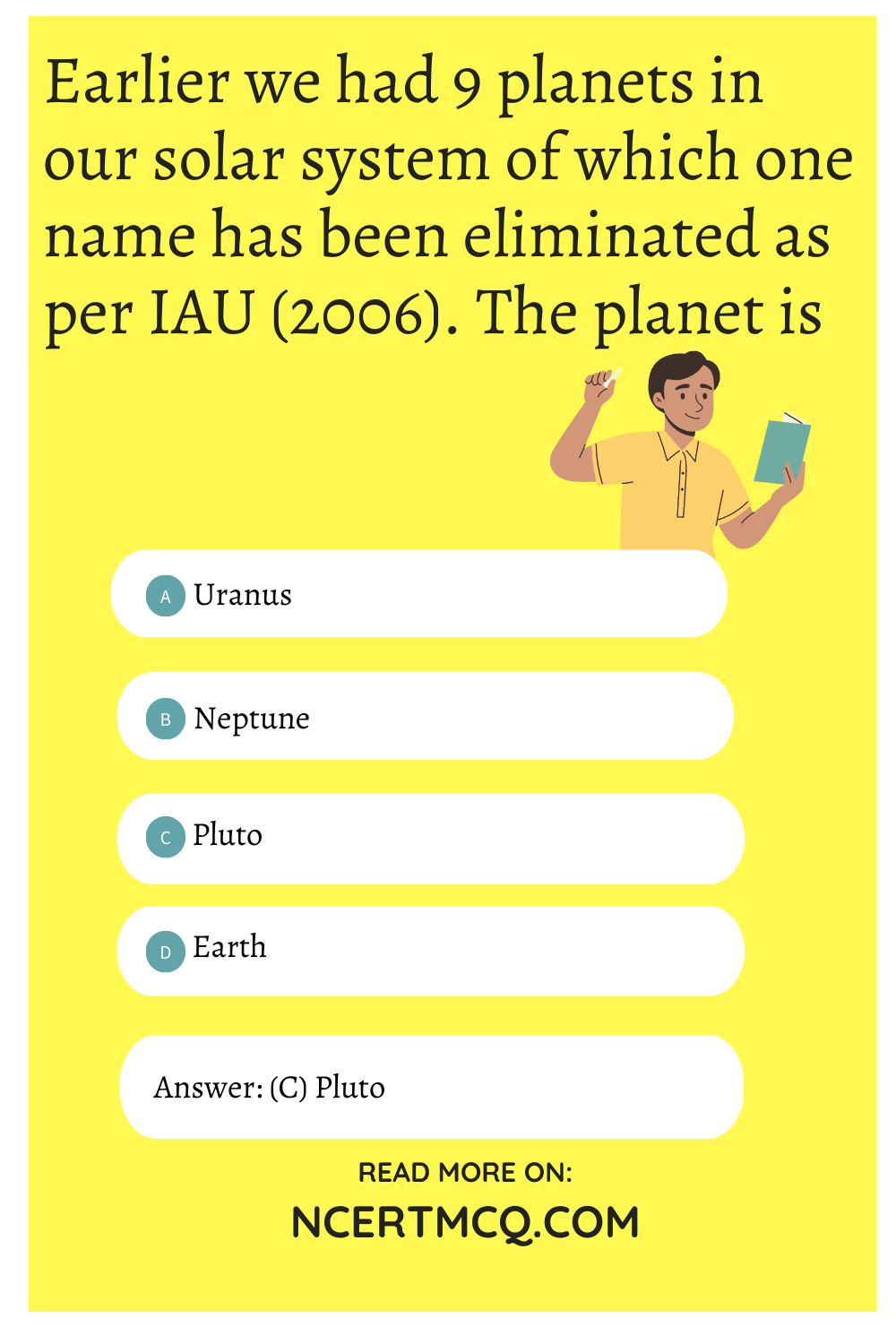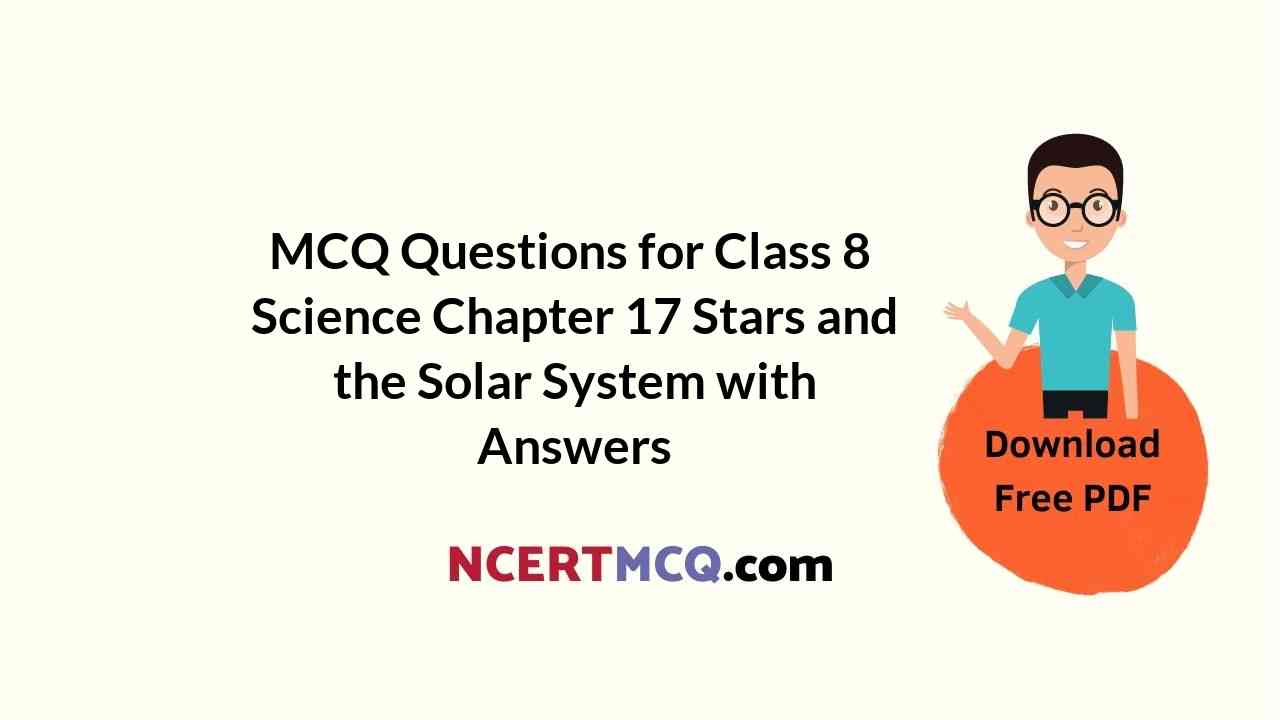Check the below Online Education NCERT MCQ Questions for Class 8 Science Chapter 17 Stars and the Solar System with Answers Pdf free download. MCQ Questions for Class 8 Science with Answers were prepared based on the latest exam pattern. We have provided Stars and the Solar System Class 8 Science MCQs Questions with Answers to help students understand the concept very well. https://ncertmcq.com/mcq-questions-for-class-8-science-with-answers/
You can refer to NCERT Solutions for Class 8 Science Chapter 17 Stars and the Solar System to revise the concepts in the syllabus effectively and improve your chances of securing high marks in your board exams.
Class 8 Science Chapter 17 MCQ With Answers
Science Class 8 Chapter 17 MCQs On Stars and the Solar System
Choose the correct option in the following questions:
Stars And Solar System Class 8 MCQ Question 1.
Which of the following does not belong to the family of solar system?
(a) Planet
(b) Galaxy
(c) Meteors
(d) Comet
Answer
Answer: (b) Galaxy
Class 8 Science Chapter 17 MCQ Question 2.
The Halley’s Comet is seen after every
(a) 76 months
(b) 76 years
(c) 56 months
(d) 56 years
Answer
Answer: (b) 76 years

Stars And The Solar System Class 8 MCQ Question 3.
Ursa Major is a
(a) star
(b) constellation
(c) seen only with telescope
(d) satellite
Answer
Answer: (b) constellation
Class 8 Science Ch 17 MCQ Question 4.
Which planet has the largest number of satellites?
(a) Jupiter
(b) Saturn
(c) Mercury
(d) Mars
Answer
Answer: (b) Saturn
Star And Solar System Class 8 MCQ Question 5.
Which unit is used to measure astronomical distances?
(a) Leap year
(b) Light year
(c) Century
(d) Sound year
Answer
Answer: (b) Light year
Class 8 Stars And Solar System MCQ Question 6.
The stars forming a recognizable shape is called
(a) constellation
(b) system
(c) galaxy
(d) asteroids
Answer
Answer: (a) constellation
MCQ Questions For Class 8 Science Chapter 17 Question 7.
Which star is nearest to Earth?
(a) Pole star
(c) Orion
(b) Cassiopeia
(d) Sun
Answer
Answer: (d) Sun
MCQ On Stars And Solar System Question 8.
What term is used for celestial bodies that revolve around the Sun in highly elliptical orbit?
(a) Comet
(b) Meteors
(c) Asteroids
(d) Planets
Answer
Answer: (a) Comet
MCQ On Stars And Solar System For Class 8 Question 9.
Which small objects revolve between the orbits of Mars and Jupiter?
(a) Satellites
(b) Comets
(c) Asteroids
(d) Meteorites
Answer
Answer: (c) Asteroids
Stars And Solar System MCQ Class 8 Question 10.
Which planet is called morning star or evening star?
(a) Venus
(b) Mars
(c) Jupiter
(d) Mercury
Answer
Answer: (a) Venus
Class 8 Science Stars And Solar System MCQ Question 11.
Our galaxy is known as
(a) Earth galaxy
(b) Sun galaxy
(c) Milky Way
(d) Constellation
Answer
Answer: (c) Milky Way
Ch 17 Science Class 8 MCQ Question 12.
Which of the following is not a planet?
(a) Mercury
(b) Saturn
(c) Jupiter
(d) Great bear
Answer
Answer: (d) Great bear
Ncert Class 8 Science Chapter 17 MCQ Question 13.
Orion is a
(a) constellation
(b) star
(c) planet
(d) satellite
Answer
Answer: (a) constellation
Stars And Solar System Class 8 MCQ Online Test Question 14.
Shooting stars are called
(a) asteroids
(b) galaxies
(c) meteors
(d) andromeda
Answer
Answer: (c) meteors
Class 8 Ch 17 Science MCQ Question 15.
The planet farthest from the Sun is
(a) Uranus
(b) Neptune
(c) Saturn
(d) Mercury
Answer
Answer: (b) Neptune
MCQ Questions On Stars And Solar System Question 16.
If I am 13 years old, I have gone round the sun ___ times.
(a) Never gone round the sun
(b) 13
(c) 26
(d) Shall go round the sun when I shall be 15
Answer
Answer: (b) 13
Question 17.
The least dense planet is
(a) Earth
(b) Jupiter
(c) Saturn
(d) Uranus
Answer
Answer: (c) Saturn
Question 18.
____ appears as a bright head with a long tail. The tail grows in size as it approaches the sun.
(a) Asteroid
(b) Comet
(c) Planet
(d) Meteor
Answer
Answer: (b) Comet
Question 19.
During a clear night sky, bright light streaks are often visible. They are called shooting stars. They are actually
(a) Falling stars
(b) Comet
(c) Meteors
(d) Planet
Answer
Answer: (c) Meteors
Question 20.
_____ was the first Indian satellite.
(a) INSAT
(b) EDUSAT
(c) IRS
(d) Aryabhatta
Answer
Answer: (d) Aryabhatta
Question 21.
If Saturn is thrown into an ocean,
(a) It will float
(b) It will sink
(c) It will dissolve
(d) It will soak all water
Answer
Answer: (a) It will float
Question 22.
It is difficult to observe Mars because
(a) It is the smallest planet of this universe
(b) It is too far away from our planet
(c) It is hidden by the glare of the sun
(d) None of the above
Answer
Answer: (c) It is hidden by the glare of the sun
Question 23.
Ravi was looking for Venus in the sky at midnight. Mohan laughed at him because Venus
(a) Appears 1-3 hours after sunrise or 1-3 hours after sunset
(b) Appears 1-3 hours before sunrise or 1-3 hours after sunset
(c) Appears 1-3 hours before sunrise or 1-3 hours before sunset
(d) Appears 1-3 hours after sunrise or 1-3 hours before sunset
Answer
Answer: (b) Appears 1-3 hours before sunrise or 1-3 hours after sunset
Question 24.
Earlier we had 9 planets in our solar system of which one name has been eliminated as per IAU (2006). The planet is
(a) Uranus
(b) Neptune
(c) Pluto
(d) Earth
Answer
Answer: (c) Pluto

Question 25.
Light Year is
(a) Year full of light
(b) Year having light work
(c) Year which earth shall become lighter
(d) Distance travelled by light in 1 year
Answer
Answer: (d) Distance travelled by light in 1 year
Match the following items given in Column A with that in Column ‘B’:
| Column A | Column B |
| (i) Nearest of the Sun | (a) Jupiter |
| (ii) Largest planet | (b) Star |
| (iii) Comets | (c) Artificial satellites |
| (iv) Alpha Centauri | (d) A constellation |
| (v) INSAT 3E | (e) Other than planets |
| (vi) Ursa major | (f) Neptune |
| (vii) Planet | (g) Mercury |
Answer
Answer:
| Column A | Column B |
| (i) Nearest of the Sun | (g) Mercury |
| (ii) Largest planet | (a) Jupiter |
| (iii) Comets | (e) Other than planets |
| (iv) Alpha Centauri | (b) Star |
| (v) INSAT 3E | (c) Artificial satellites |
| (vi) Ursa major | (d) A constellation |
| (vii) Planet | (f) Neptune |
Fill in the blanks with the appropriate words:
1. ………….. are celestial bodies of the universe and continuously emit heat and light.
Answer
Answer: Stars
2. ………….. is the distance travelled by light in one year and is equal to 9.46 × 1012 kilometres.
Answer
Answer: Light year
3. ………….. is the star which appears to be stationary near the northern horizon.
Answer
Answer: Pole Star
4. ………….. is a group of stars arranged in a definite pattern.
Answer
Answer: Constellation
5. ………….. are bright objects that revolve around the Sun.
Answer
Answer: Planets
6. ………….. constitutes Sun, eight planets with their moons and all other objects that are bound to the Sun due to gravity, e.g., asteroids, comets and meteors.
Answer
Answer: Solar system
7. ………….. are minor planets that revolve around the Sun and are located between Mars and Jupiter.
Answer
Answer: Asteroids
8. ………….. are very small sized bodies that revolve around the Sun in highly elliptical orbits and are characterized with a small head and a long tail.
Answer
Answer: Comets
9. ………….. are small stony or metallic bodies (meteors) travelling in interplanetary space that actually reach the Earth’s surface.
Answer
Answer: Meteorites
10. ………….. are the celestial bodies revolving around a planet.
Answer
Answer: Satellites
State whether the statements given below are True or False:
1. Sun is a star
Answer
Answer: True
2. Orion has 10 bright stars
Answer
Answer: False
3. Mercury has no satellite of its own
Answer
Answer: True
4. Planets do twinkle
Answer
Answer: False
5. Jupiter is the largest planet.
Answer
Answer: True
We hope the given NCERT MCQ Questions for Class 8 Science Chapter 17 Stars and the Solar System with Answers Pdf free download will help you. If you have any queries regarding Stars and the Solar System CBSE Class 8 Science MCQs Multiple Choice Questions with Answers, drop a comment below and we will get back to you soon.
Class 8 Science MCQ:
- Crop Production and Management Class 8 MCQ
- Microorganisms: Friend and Foe Class 8 MCQ
- Synthetic Fibres and Plastics Class 8 MCQ
- Materials: Metals and Non-Metals Class 8 MCQ
- Coal and Petroleum Class 8 MCQ
- Combustion and Flame Class 8 MCQ
- Conservation of Plants and Animals Class 8 MCQ
- Cell Structure and Functions Class 8 MCQ
- Reproduction in Animals Class 8 MCQ
- Reaching the Age of Adolescence Class 8 MCQ
- Force and Pressure Class 8 MCQ
- Friction Class 8 MCQ
- Sound Class 8 MCQ
- Chemical Effects of Electric Current Class 8 MCQ
- Some Natural Phenomena Class 8 MCQ
- Light Class 8 MCQ
- Stars and the Solar System Class 8 MCQ
- Pollution of Air and Water Class 8 MCQ
